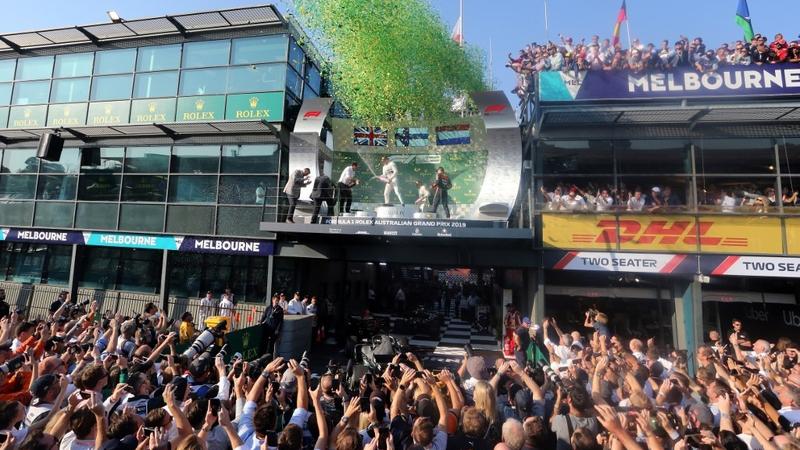 Mercedes' Finnish driver Valtteri Bottas (C) celeberates on the podium after the Formula One Australian Grand Prix in Melbourne on March 17, 2019. (ASANKA BRENDON RATNAYAKE / AFP)
Mercedes' Finnish driver Valtteri Bottas (C) celeberates on the podium after the Formula One Australian Grand Prix in Melbourne on March 17, 2019. (ASANKA BRENDON RATNAYAKE / AFP)
BEIJING - The off-season break is over, pre-season testing is complete, and the 2020 Formula 1 season kicks off next weekend with the Australian Grand Prix in Melbourne.
First joining the F1 calendar in 1985 with a race around the streets of Adelaide, the Australian Grand Prix moved to Melbourne in 1996 and assumed its now-customary status as the season's curtain-raiser.
Held on public roads around the city's Albert Park, the Melbourne event has long been a favorite among teams, drivers and fans
ALSO READ: Hanoi Circuit completed, ready for Vietnam Grand Prix in April
Held on public roads around the city's Albert Park, the Melbourne event has long been a favorite among teams, drivers and fans, with a carnival atmosphere adding to the excitement surrounding the start of a new campaign.
Though the Albert Park circuit doesn't always lend itself to easy overtaking, its tight confines and unforgiving walls leave drivers with little margin for error, and races are frequently enlivened by the deployment of the safety car.
Over the years, both Adelaide and Melbourne have played host to races of high drama, tension and intrigue, including a couple of title-deciding showdowns, and Xinhua takes a look back at five of the best Australian Grands Prix.
1986 - Perfect Prost pips peers at post
The second running of the Australian Grand Prix was the setting for a titanic three-way championship battle between the two Williams cars of Nigel Mansell and Nelson Piquet, and Alain Prost's McLaren.
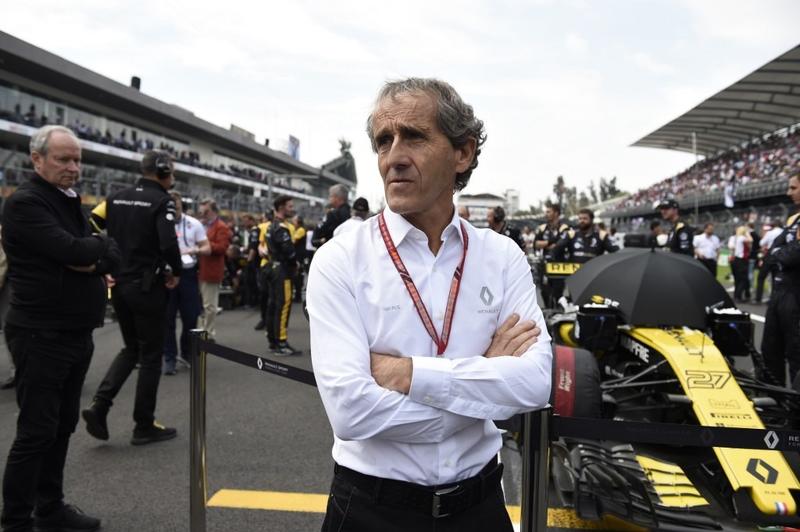 French former F1 champion and special advisor to Renault Sport F1, Alain Prost, is pictured prior to the start of the F1 Mexico Grand Prix at the Hermanos Rodriguez circuit in Mexico City on Oct 28, 2018. (ALFREDO ESTRELLA / AFP / POOL)
French former F1 champion and special advisor to Renault Sport F1, Alain Prost, is pictured prior to the start of the F1 Mexico Grand Prix at the Hermanos Rodriguez circuit in Mexico City on Oct 28, 2018. (ALFREDO ESTRELLA / AFP / POOL)
With a points advantage over his rivals, Mansell only needed to finish third to be sure of the title, and he drove conservatively in the opening stages of the race to look after his car.
But just when it seemed that the championship was destined to fall to the Englishman, a spectacular tyre failure pitched him off the road and out of the race.
Piquet was now leading, but the Williams team, wary of what had happened to Mansell, called him in for a precautionary tyre change, allowing a disbelieving Prost through to win the race and take the 1986 title.
1991 - The shortest race
Visitors to the 1991 Australian Grand Prix would have been in for a nasty shock, as after bright sunshine for practice and qualifying, Sunday's race was run in torrential rain.
Despite rumors of a cancelation, the race went ahead as planned, but with many cars spinning off and debris strewn around the circuit, it quickly became apparent that the conditions were too treacherous to race in.
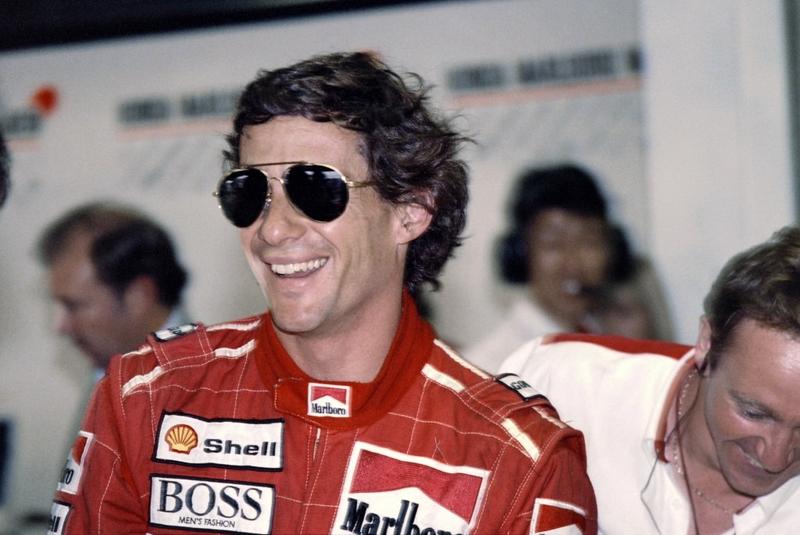 Brazilian Formula One driver Ayrton Senna smiles after getting the pole position of the Australian Formula One Grand Prix on Nov 2, 1991, in Adelaide. (TOSHIFUMI KITAMURA / AFP)
Brazilian Formula One driver Ayrton Senna smiles after getting the pole position of the Australian Formula One Grand Prix on Nov 2, 1991, in Adelaide. (TOSHIFUMI KITAMURA / AFP)
It was too much even for race leader and rain specialist Ayrton Senna, who frantically waved his arms to gesture for the race to be red flagged, and after just 14 laps of a planned 78, organizers called a halt to proceedings.
Afterwards, many drivers were critical of the decision to start the race at all. Senna complained that it was just a matter of trying to stay on the circuit, while second-placed Nigel Mansell branded the situation "a complete joke".
1994 - Title rivals clash in showdown
At the end of one of the most tragic and controversial seasons in F1 history, just one point separated title contenders Michael Schumacher and Damon Hill as the circus headed to Adelaide for the final race of 1994.
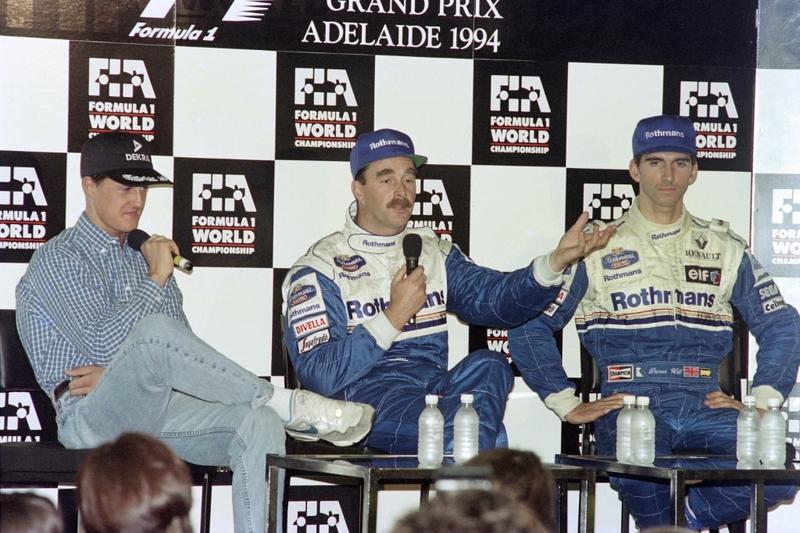 German formula one driver Michael Schumacher (L) and British drivers Nigel Mansell (C) and Damon Hill (R) give a press conference on the eve of the Australian Formula One Grand Prix on Nov 12, 1994, in Adelaide. (GREG WOOD / AFP)
German formula one driver Michael Schumacher (L) and British drivers Nigel Mansell (C) and Damon Hill (R) give a press conference on the eve of the Australian Formula One Grand Prix on Nov 12, 1994, in Adelaide. (GREG WOOD / AFP)
Both drivers were in a class of their own from the off and quickly pulled out a big lead over the chasing pack, with Schumacher ahead of Hill.
The race's defining moment occurred on lap 36, when Schumacher ran wide and tapped the outside wall with his right front tyre.
Sensing an opportunity, Hill moved to overtake him at the following right-hander, but the German turned in sharply and the two collided, forcing both drivers to retire.
Though the legality of Schumacher's move was called into question, ultimately no action was taken against the German, and he duly claimed his first of seven world titles.
2002 - First lap carnage
The 2002 Australian Grand Prix will forever be remembered for a multi-car pile-up on lap 1 that saw eight drivers out of the race at the first corner.
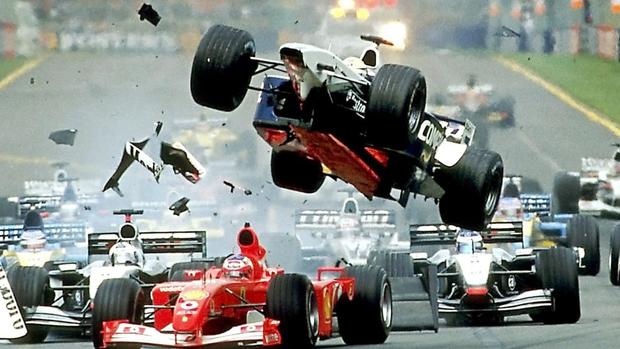 Williams driver Ralf Schumacher (C) is launched in the air over Ferrari driver Rubens Barrichello of Brazil (front red) in a dramatic Australian F1 Grand Prix, at the Albert Park Circuit in Melbourne, 03 March 2002. (HANDOUT / AFP)
Williams driver Ralf Schumacher (C) is launched in the air over Ferrari driver Rubens Barrichello of Brazil (front red) in a dramatic Australian F1 Grand Prix, at the Albert Park Circuit in Melbourne, 03 March 2002. (HANDOUT / AFP)
Ralf Schumacher had made a fast start and was closing on polesitter Rubens Barrichello, but misjudged his braking point and went flying over the top of the Brazilian, with the ensuing confusion also eliminating several midfield runners.
Despite stricken cars and debris all over the circuit, the race was surprisingly not restarted, and the high attrition rate allowed some smaller teams a rare chance to score championship points.
Michael Schumacher won the race, but the real story was that Australia's Mark Webber had avoided the carnage to finish fifth on his Grand Prix debut, scoring his Minardi team's best result for eight years.
After the race, Webber and team boss Paul Stoddart were given the opportunity to have their own private podium ceremony, to the delight of the partisan home crowd.
2010 - Button masters slippery track
Rain before the start of the 2010 Australian Grand Prix meant all the drivers started on intermediate tyres, but with the track drying rapidly, choosing the right moment to pit for slicks would prove vital.
 Reigning world and defending champion Jenson Button of Britain celebrates on the podium with champagne after winning Formula One's Australian Grand Prix in Melbourne on March 28, 2010. (TORSTEN BLACKWOOD / AFP)
Reigning world and defending champion Jenson Button of Britain celebrates on the podium with champagne after winning Formula One's Australian Grand Prix in Melbourne on March 28, 2010. (TORSTEN BLACKWOOD / AFP)
Lying in seventh place, Jenson Button was the first to change tyres on lap 6, only for the McLaren driver to slide off the track almost as soon as he had rejoined, illustrating how tricky the conditions were.
READ MORE: Hamilton warns he will be 'a machine'
However, Button soon found his rhythm and began pumping in quick lap times, prompting other drivers to follow his lead and pit for dry tyres.
By the time the rest of the field had made their stops, Button was now in second position, his earlier gamble having paid off handsomely, and when Sebastian Vettel retired with a brake issue, Button assumed the lead and coolly collected his first win for McLaren.


